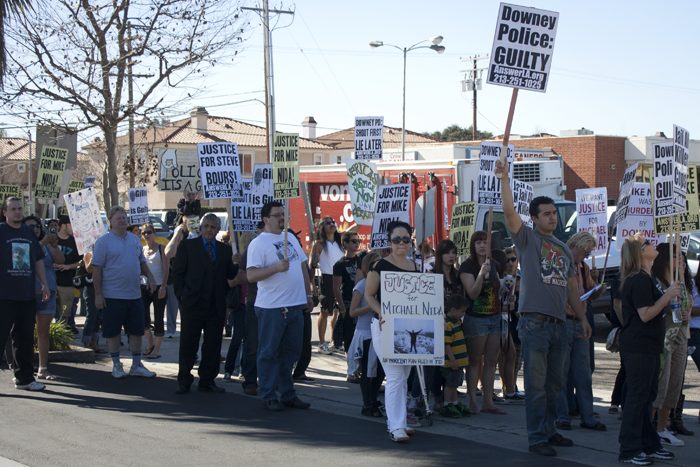An assortment of protestors gathered at the corner of Imperial Hwy. and Paramount Blvd. on Jan. 28 to protest the Downey Police Department and City Council for what they claimed was their lack of police restraint. The protest rally took place at the location where Michael Nida, 31, was shot by the Downey P.D. on Oct. 22, 2011.
Although the protest was largely coordinated by the relatives and friends of the deceased Nida, the rally made sure to include family members who have had similar confrontations with the police. Coincidently, the site of the rally was the same location where military veteran Steven Bours was killed by the Downey P.D. 22 months prior.
At the vanguard of the protest area stood Damion Ramirez, a close friend of Nida, who orated to the group about the “injustice and disrespect” that the Downey City Council has given the family. The atmosphere was tinged with a mixture of buzzing excitement and tense anger. Relatives, friends, and interested individuals partook in the event, totaling to about thirty people at the time. All around, participants held signs that read “Down With Downey,” “Killer Cops Are Not Welcome,” and “Downey: Shoot First, Ask Questions Never.” The people chanted things such as “Downey P.D. you are guilty!”
“It’s just not fair,” Downey resident Clarence Durden said. “It’s just not. These guys run around with impunity, that’s what it is. I’m here to try and put a stop to that by letting the cops know that they will be stopped. They can’t keep doing what they’ve been doing.”
And that’s exactly what the protest march aimed to do: place the alleged corruption of the city into the eyes of the citizenry in the hopes that some positive action will come about.
The Campaign to Stop Police Violence, a minor branch of the Act Now to Stop War and End Racism (ANSWER) coalition, has made it a high priority to bring justice to Downey by aiding the Bours family and applying pressure on the D.P.D. to sway them towards reforming. Headed by Doug Kauffman, the coalition seeks to right all the wrongs that have occurred due to the “negligence of the police force”.
A representative of the association, Gabriella Rubias, stated that:
“I’m here because police brutality is a serious issue, especially in working class communities where you’re the most vulnerable,” Rubias said. “The police should not be able to get away with these things. They should be held accountable. So that’s why the ANSWER Coalition is here: to show solidarity with the Nida family and to serve justice.”
After the rallying was over the group began to march north towards the city hall on Brookshire. As the marching continued, the amount of demonstrators increased. At the end, well over ninety people amassed to show their support for the cause. The march was so large, in fact, that traffic was halted as the group moved onward to their destination.
At the forefront of the march were Jean and Jerry Thaxton, Nida’s parents. Alongside them, a representative from the ANSWER coalition repeated chants to the large group as they walked, bolstering their resolve.
At last, the march ended at the City Hall building where Jean Thaxton gave a small speech. Others who knew Nida fondly also spoke for a short while, continuously stressing their discontent with the rough manner in which Nida was treated.
Damion Ramirez had this to say about the protest:
“We want to make the community more aware,” Ramirez said. “We’ve discovered that in the three months since Mikey was killed, the city of Downey hasn’t been doing anything to educate its citizens about what happened. The people need to know.”
The details surrounding Nida’s death are hazy at best, given that officials, media outlets, relatives, and friends of Nida all give different accounts of what transpired; the stories, however, do acknowledge that Nida was accosted by the police under suspicion of involvement with an ATM robbery. From there on, the story delves into different tracks. Yet, every story shares the same ending: Nida was shot four times in the back by police, and the police would later acknowledge that he was, in fact, not involved with the robbery.
Currently, an investigation is being conducted by the LA County Sheriffs. As an impartial investigator, the LA Country Sheriffs is the most reliable way to get an objective analysis of the case. When the police department is finished with its research, it will send its results to the court which will then decide on a verdict.
As unfortunate as a loss of life is, it is a reality that any city must deal with. Interestingly, the case surrounding Bour’s death is strikingly similar to Nida’s: both families believed their loved one was unjustly shot, appealed to a court, and had a protest. In the end, the justice that the Bour family longed for was not administered. What does this portend for the Nida family? One can only guess.




